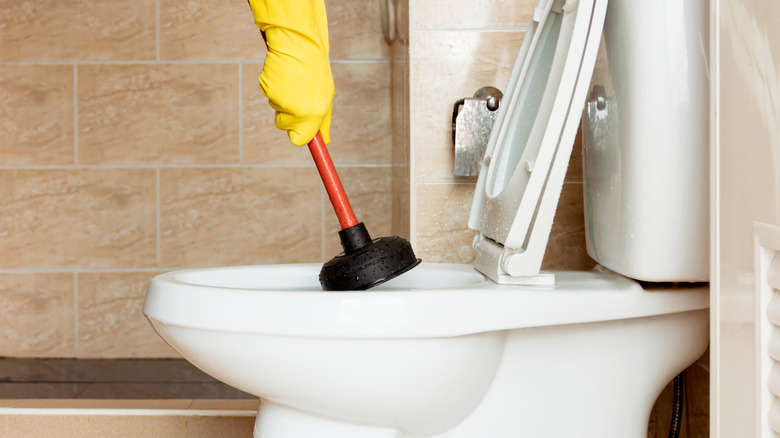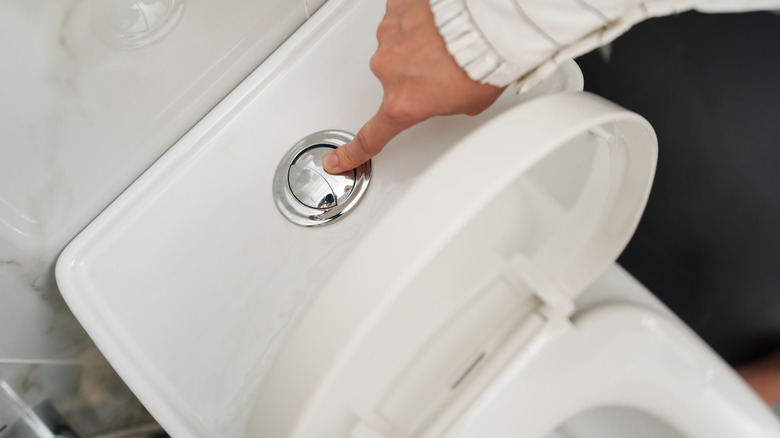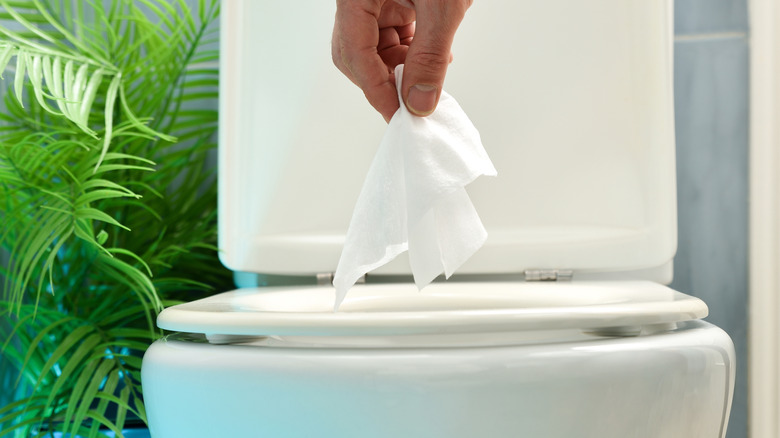The Secret Way To Tell If Your Toilet Is Prone To Clogs
If seeing the water level rise or drain slowly when you flush your toilet is another Tuesday for you, chances are your lavatory gets blocked. There could be numerous reasons why your toilet clogs. Flushing sanitary products, wet wipes, small toys, or a big wad of toilet paper in one go are a few common culprits. These objects choke the water flow from the trap to the sewer, leading to congestion. If you're tired of dealing with a clogged toilet trap every few days, there are a few signs that suggest your fixture is prone to obstacles. Certain kinds of U-bends, for example, are more likely to cause issues.
To understand this better, House Digest spoke exclusively with Joseph Wade, VP of operations at Benjamin Franklin Plumbing. "The U-bend (also called a trap) is the curved part of the toilet or drain pipe that holds a little bit of water," he told us. "This water acts like a seal, keeping gross sewer gases from coming back up into your home." It also directs the flow of the solid matter. Elaborating on the most familiar shapes, he explained the P-trap. "This looks like a "P" on its side and is most common in sinks," he said. "It connects sideways into the wall." Moreover, "A P-trap vents better and is less likely to cause problems." Comparatively, an S-trap "looks like an 'S' and usually goes straight down into the floor." According to Wade, these designs are older and not as common anymore due to suction problems. Besides the trap shape, you also want to keep an eye on your toilet's flushing mechanism, water flow, and plunging requirements.
The trap is one of the most common causes of toilet blockage
In his exclusive interview with House Digest, Joseph Wade said the shape of the trap is one of the most common causes of a clogged toilet. "If the bend is too sharp or narrow, waste and toilet paper can get stuck more easily," he explained. This is because it's harder for the waste matter to make its way down toward the sewer. Similarly, Wade said "an S-trap with a tight curve can be more clog-prone than a smoother, wider trapway." So, when you go toilet shopping and look at the three styles, he recommends opting for toilets with "wider, smooth-flowing trapways (like modern toilets with a good flush design)." To keep clogs to a minimum, Wade warns against "toilets with sharp, narrow bends or older S-traps without proper venting."
There are other common indicators that your toilet is prone to clogs. For instance, antiquated drain lines affect the movement of solid and liquid waste from the bowl to the sewers. Listing a few other signs, Wade iterated that the flushing prowess of your lavatory determines the presence of clogs, too. "If the water doesn't move waste forcefully, it's more likely to clog," he explained. Narrow trapways with "smaller internal pipes" will lead to more unwarranted blockages, too. Abysmal water flow is another thing to look out for. "Older or low-flow toilets may not have enough power to clear everything," Wade warned. Additionally, if you have to plunge your toilet often, that's a sign that your fixture has an issue.
Preventing your toilet from clogging regularly
If you can't afford to replace your toilet yet, you can follow a few best practices to ensure clogs don't become a regular thing. The first step is to avoid flushing certain items, including hair clumps, used dental floss, wiped napkins, dirty diapers, sanitary products, cotton balls, plastics, or medicines. Basically, don't put anything into the bowl that it's not meant to flush away. Joseph Wade agreed in his exclusive interview with House Digest: "Flush only toilet paper and waste. No wipes — even the "flushable" ones!" Even when you're disposing of used toilet paper, be mindful of the amount you flush in one go. "Don't overload the bowl," he advised. "Flush more than once if needed."
In case you find that wasteful or don't want to increase your water bills, Wade suggested cutting down on the amount of toilet paper you use. If that's not possible, try buying thinner varieties — they dissolve more quickly than their thick counterparts. Alternatively, install a bidet. You should also check that the toilet is flushing strong. If not, adjust the water level of your tank and check for a blockage. You also want to keep a plunger nearby. Whenever you notice a partially blocked trap, use the tool to clear the path and prevent the clog from snowballing. But what do you do when nothing works? "Have your toilet inspected by a professional like Benjamin Franklin Plumbing Licensed Technicians if clogs keep happening," Wade suggested. "You might need a better toilet or a fix to the pipes."


